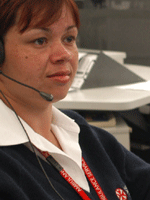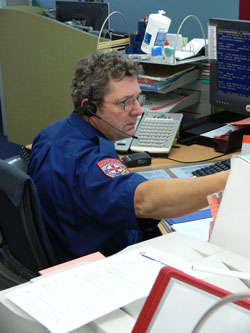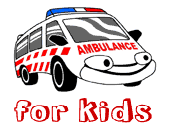Ambulances are dispatched within seconds of receiving your call, but to ensure the paramedics are fully informed you will be asked a standard series of questions while the ambulance is on it's way. These questions will usually include:
|
Listen to Audio - Adult call
This text will be replaced by the flash music player.
|
|
Listen to Audio - Child call
This text will be replaced by the flash music player.
|
![]() If you are unable to listen to the above interactions please download the Flash player here
If you are unable to listen to the above interactions please download the Flash player here

Follow the call taker’s instructions
- Special circumstance apply in remote and rural areas and it’s important you follow the call taker’s instruction to help care for the patient until the ambulance arrives and to help the ambulance find your property.
- Remember, Ambulance Paramedics are highly trained and they bring the latest medications and equipment to the patient, make it as easy as possible for them to locate you.
- Just because you don’t live near an ambulance branch, don’t assume there isn’t an ambulance nearby. Ambulances are constantly moving about and one may be passing nearby at any time. Don’t take the risk of driving yourself, call an ambulance.

- Try not to panic, and continue to administer medications.
- Give good directions, and try to use the correct names of roads rather than what the “locals” call them.
- Landmarks, such as “the white house with the red tin roof” for example, can help the ambulance crew locate your property.
- Stay with the phone. If it’s cordless take it with you as you move around. The call taker may want to ring you back.
- Provided someone stays with the phone and the patient, send someone to the front of the property or a nearby intersection to meet and direct the ambulance.
- People driving themselves to hospital in urgent medical situations have often been involved in accidents not only injuring themselves, but also other road users. It is also difficult to continue to administer medications while you are driving.
- On rare occasions in remote areas and where the patient’s condition allows it, the call taker may ask you to start moving towards the on-coming ambulance. If this is the case, give the call taker your mobile phone number and remember to take your mobile with you. If it’s night, also take a torch. Follow the call taker’s instructions and don’t go past the arranged rendezvous point: the ambulance may not be coming from the direction you assume and you may miss it.
- Ambulance officers are highly trained health professionals. They bring modern emergency and resuscitation equipment to the patient and commence lifesaving treatment at the scene as well as continuing this on the way to hospital.
- It is important to teach children how to call 000 and advise the call-taker of their name, address, phone number and reason for calling. Listen to the children’s 000 call at the top of this page.
- Put your address and telephone number on your phone in case a visitor has to call for assistance for you.

000 For Those With Hearing, Language and Speech Impairments
The 000 emergency network has a number of strategies to assist people with hearing or speech impairments or limited language skills.
Interpreter services
If a call taker cannot understand a caller they can access the interpreter service and establish a three-way conversation to facilitate communication.
Hearing or speech impairment
People with hearing or speech impairments can gain access to the ambulance emergency number by dialling 106 through a Text Telephone (TTY) or computer with modem. The 106 number provides the same service as the 000 emergency service, but is only for people who are deaf or have a hearing or speech impairment. 106 is a toll-free number provided as part of the National Relay Service. This text based emergency service allows callers to pass on text information to a relay officer, who dials the correct emergency service and relays the conversations.
 |
